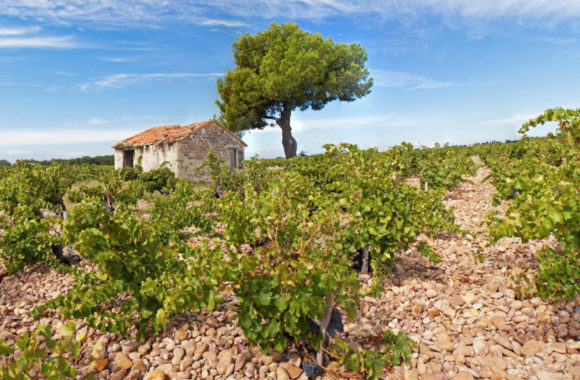
An Introduction To: Pests & Diseases
· Maggie Macpherson Maggie Macpherson on
Jeroboams Education is a new series on our blog providing you with the lowdown on the most iconic wine producing regions of the world, along with fundamental information on the production of beer, cider, wine and spirits. Led by our super buying team, Peter Mitchell MW, Maggie MacPherson and James Phillips will introduce you to the key facts and a little history of all the regions, styles and types you recognise but perhaps don’t know too well. To help really further your education, why not drink along? Browse our Wines.
Introduction
All keen gardeners will know the pain of popping down to the allotment and seeing that Peter rabbit has been at your carrots, turbo the snail has feasted on your lettuce, and there seems to be a plague of aphids hell bent on sucking your raspberry plants dry. Well, the same goes for grape growers, although I hazard on a slightly larger and more costly basis. So devastating can these pests and diseases be that one such pest, Phylloxera, almost devastated the entire European wine industry in the late 19th century, and still affects regions today such as Yarra Valley in Australia. Before we jump into the nitty gritty, it’s worth understanding the differences between pests and diseases. A pest is defined as an organism that occurs where it is not wanted or an organism that has a detrimental effect on the vines. There are two kind of pests; physical pests (such as deer), and those pests which transmit diseases. When it comes to diseases, these can be broadly split into fungal/bacterial or viral diseases. Below we’ll focus on the current pests and diseases which winemakers need to tackle each vintage.
Physical Pests
Physical pests are probably one of the easier pests to manage in a vineyard as you can see them and the effect they’ve had on the vineyard easily and then look to protect the vineyard against them going forward. Each country/region has different pests to contend with, in Australia deer and kangaroos wreak havoc, while its the wild boar in Italy, France & Germany which can plunder a vineyards fruit. Birds cause issues across the globe, while in South Africa their pests are the blue bottomed baboons. The obvious issue is that these animals eat the fruit thereby reducing yields, in Australia kangaroos can east up to 150kgs of fruit in a day! However, physical pests can also encourage disease in the vine and larger animals may damage vineyard infrastructure. So, how can a grower prevent these pests from feasting? Well fencing and netting are great for keeping pests out but add extra costs in maintenance and labour. Some favour air cannons or noise emitters to frighten off would be fruit burglars however these can also negatively affect the surrounding environment, same as with physical barriers. An ecological bird preventative measure which is picking up in popularity is to employ a falconer to use their falcons to discourage smaller birds. This method is already being used at the Robert Sinskey vineyards in California. Robert Sinskey wanted to find an alternative to bird netting as it cantrap many non-target species like hummingbirds, dragonflies, and seed- and bug-eating songbirds.
Pests that Transmit Diseases
Insects are the common culprit of pests which transmit diseases and are differentiated by the type of feeding that they do, and this is key to identifying which insect is responsible for the damage. When a pest has been identified a grower must choose a course of action to cure and then prevent the pests from returning. For this type of pest, you may think producers reach straight for the pesticides and many do, however there is an increasing emphasis on approaching these pests in a more holistic way. Growers are focusing on prevention by creating healthy and self-balancing habitats through the use of natural predators, discouraging pest reproduction through the application of pheromones, and by removing pests preferred habitats such as certain grasses or plants.
Nematodes
These are parasites native to Asia and Europe which feed on the vine’s roots limiting the capacity of the vine to uptake water & nutrients. The Dagger nematode is also responsible for transporting the fanleaf virus. If soils are found to be infected, the practice of leaving soils fallow for several years prior to replanting is helpful and although this is an expensive cure, some premium producers such as Dominus in California choose this method. Cheaper prevention methods involve using certain cover crops, like mustard, which are believed to produce toxins unfavourable to nematodes, and there are now Nematode resistant rootstocks.
Mites
The mites we refer to here are the diminutive cousins of spiders rather than the wee ones you’ve been home-schooling for the best part of a year… They’re actually very common in vineyards with only some species damaging vines by feeding on the chlorophyll in the leaves. This causes discoloration and reduces the vines photosynthetic capacity which in turn can delay ripening, although this is only a threat if the population grows out of control. As mites thrive in dusty conditions the main preventative measure is to keep dust to a minimum in vineyards, particularly when driving through the vines. There are also predatory mites which feed on the undesirable beasties, Roederer make use of these in their Champagne vineyards.
Glassy-winged Sharpshooters
In case you were curious, these are my favourites pests, the name is fantastic! These are a sucking insect which vector Pierce’s disease, which we’ll discuss later. Birds are a useful ally when fighting these sharpshooters, particularly bluebirds. I really only mentioned these pests because I like the name…
Suzukii Fruit fly & European grapevine moth
These insects damage the fruit and open it up to infection by Botrytis (the bad kind) and other pathogens. The grapevine moth lays its eggs inside grapes (essentially, they are the alien of the wine pest world – grim) where its offspring hatch, consume the pulp and fly away to infect more fruit. If attacked early in the vintage affected grapes shrivel and drop off resulting in marginal crop loss. However, if left too late like when grapes are juicy, the affected berries won’t shrivel but drip and the result is sour rot that can spread to the entire cluster. Europe has dealt with the moth issue for a long time, however wineries in North America still have issues, such as Hermann J. Wiemer in New York state who can’t fight them like the Europeans do using Pheromones to disrupt mating as this isn’t available in the US yet. However, when it comes to the fruit fly Herman J Wiemer have found that pulling leaves, effectively eliminating the fly’s shady home has produced good results.
Phylloxera Vastatrix
This is the famous louse which feeds on the vine’s roots! This is not fatal, but the punctures allow the plant to become infected by pathogens in the soil. Sadly, Europe’s native Vitis Vinifera grape varieties are highly susceptible, which is why most Vinifera is now grafted to American rootstocks which are naturally resistant (Phlloxera originated in the USA). Phylloxera free regions such as parts of South Australia, Argentina & Chile enforce strict quarantine protocols to limit Phylloxera’s spread.
Bacterial/Fungal Diseases
Powdery & Downy Mildew
These are fungal diseases with Powdery Mildew being particularly troublesome in California & other Mediterranean climates. They’re caused by dormant mildew spores settling in buds and under favourable conditions these spores multiply to cause infection. Downy prefers cool and moist conditions, while Powdery prefers it dry and somewhat hot. Again, Vinifera varieties are highly susceptible and particularly Cabernet Sauvignon, Carignan & Chardonnay. These diseases won’t kill the vine but can have a negative effect on vine health and ultimately fruit quality. There is no silver bullet for curing these diseases, and much like with an old building and damp, they must be managed. Vineyard sprays of sulphur or systemic fungicides on the canopy at regular intervals throughout the growing season keep them at bay. Producers wanting to avoid sprays of any kind can use effective canopy management choices to minimise risk, with good airflow in the vines creating an environment that’s less mildew prone.
Pierce’s disease
This is a bacterial disease which resides in the water-conducting system of the grapevine and is spread primarily by our old enemy the Glassy-winged sharpshooter. Pierce’s causes the vine leaves to become yellow and the edges may dry suddenly making the leaves look scorched. The severity of this disease varies depending on the vine species and variety, with Pinot Noir and Cabernet Sauvignon being particularly susceptible. Susceptible varieties can die within one to two years of the initial infection. However, there is no cure for Pierce’s disease, so prevention is the best option through removal of infected vines to reduce the spread of disease and practicing good hygiene to ensure “come clean, go clean” when entering vineyards.
Trunk Diseases
Trunk Diseases became particularly prevalent in Europe in 2012 with Cabernet Sauvignon & Sauvignon Blanc being especially susceptible, but recently spreading to other varieties such as Pinot Noir & Chardonnay. There is a common thought that wood rot diseases are the most severe threat vineyards are facing right now.
Eutypa dieback
This trunk disease is caused by several different fungus which during autumn/spring rainfall release spores and wounds made by intensive pruning, frost and other mechanical injuries provide infection sites. Wounds can remain susceptible to infection for several weeks. Symptoms appears in mature vines of 5-7 or even 20 years old, but the infection itself occurs in younger vines. The most obvious symptoms are a delay in shoot emergence in spring, with shoots that eventually grow displaying dwarfed chlorotic (yellowing) leaves sometimes with a cupped shape. Eventually the disease can cause spurs, arms, cordons, canes and the upper section of the trunk to die. Preventative practices (delayed pruning, double pruning, and applications of pruning-wound protectants) are the most effective management approach for all trunk diseases, especially when adopted in young vineyards (e.g. under 5 years old) and used annually.
Esca
This disease is currently ravaging Europe and finds its way into vines in much the same way as Eutypa dieback. It also affects vines of a similar age to Eutypa dieback, namely mature vines display symptoms, but the infection occurred while it was younger. However, its symptoms differ with red varietals displaying dark red stripes on their leaves, while white varietals show yellow before drying out completely with the eventual dieback of the entire vine occurring if not treated. A severe form of Esca known as “apoplexy” is more common in Europe and results in a sudden dieback of the entire shoot or adjacent shoots, rather than a gradual development of symptoms. As this is a relatively new disease it is yet to be thoroughly studied and there seems to be no cure. One theory is that it is the pruning rather than the fungi themselves that provoke the disease, and as such some vine clippers have been designed to inject a disinfectant when used. Another tactic is to reduce the size of the cuts, which can be achieved by switching from cordon to cane pruning.
Viral Diseases
Viral diseases are perhaps the least understood of all the diseases to plague growers. Part of the confusion stems from the fact that viruses rarely work alone with an affected vine typically housing several viruses at the same time. Also, as very few viruses kill vines, there hasn’t been the same pressure to research them. There are also those who credit a particularly rampant virus in California in the 1960’s and 70s for producing those wines of relatively low ABV. Some are even discussing the use of viruses as a weapon against overripeness to combat the effect of global warming. Generally, viruses are spread either by pests or using unclean nursery material.
Red Blotch
This virus was only discovered in the last decade and was previously confused with Leafroll virus. Subsequently Scientists at UC Davis tested some archived dried grape and identified that red blotch has been present in California since at least the 1940s. Unlike leafroll, the leaves don’t curl, but they do turn red. This discoloration limits ripening, but unlike leafroll, it can affect the flavour of the fruit & therefore the resulting wine. Recently, several research efforts have been initiated to try to determine the taste threshold of red blotch-affected wines, which some experts put at around 5%.
Leafroll
This virus causes leaves to turn red and curl in on themselves. The yield is unaffected, but the ripening will be reduced. It is generally spread by a mealybug, however, can also be spread by use of infected vine cuttings. Where mealybugs are the cause a grower must first tackle reducing this pest population, Craggy Range usedpheromone traps and planted red clover in more fertile sites in the hope that the bugs would turn to the clover as a food source instead of the vines.







